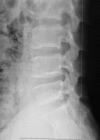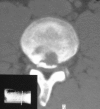A review of current treatment of lumbar posterior ring apophysis fracture with lumbar disc herniation
- PMID: 23179980
- PMCID: PMC3585633
- DOI: 10.1007/s00586-012-2580-9
A review of current treatment of lumbar posterior ring apophysis fracture with lumbar disc herniation
Abstract
Purpose: Lumbar posterior ring apophysis fracture (PRAF) is an uncommon disorder frequently accompanied by lumbar disc herniation (LDH). Over the years, there have constantly been published studies concerning this disorder. Due to its rarity, there is lack of an agreed treatment strategy, and lots of different opinions exist, including the choice of decompressive modalities, whether removal of apophyseal fragments or/and disc material, and the necessity of additional spinal fusion. The purpose of this review is to provide a collective opinion on the treatment of PRAF with LDH.
Methods: A MEDLINE search in the English language literature was performed from 1980 to 2012. To be included in the study, it was strictly necessary for each clinical article to provide information about the description of apophyseal fracture such as location, treatment methods and clinical outcome. The studies were mainly analyzed for general features, the related classifications and treatments.
Results: The literature searching yielded 19 articles reporting 366 patients experiencing 380 sites of fractures. All of them were case reports or case series. The classification systems of PRAF were various based on the morphology, mobilization, size or localization, and relationship between disc and fragment. The most used surgical options were posterior discectomy simultaneous excision of apophyseal fragments without spine fusion. Surgical treatment for PRAF with LDH had equally excellent clinical outcome compared with LDH alone.
Conclusions: The diverse features of apophyseal fracture lead to various modalities of classifications and operation options. Prior to operation, the surgeons should carefully make a plan to consider decompressive scope, removal of apophyseal fragment or/and disc and fusion or not. Because of methodological shortcomings in publications, it is not possible to definitively conclude what treatment modality is the best for the treatment of PRAF. More high-quality clinical studies are needed to draw more confirmable conclusions.
Figures





Similar articles
-
Percutaneous endoscopic interlaminar discectomy for posterior ring apophyseal fracture accompanied with lumbar disc herniation in a 12-year pediatric diver: a case report.Childs Nerv Syst. 2023 Jan;39(1):275-278. doi: 10.1007/s00381-022-05605-5. Epub 2022 Jul 7. Childs Nerv Syst. 2023. PMID: 35798908 Free PMC article.
-
Posterior ring apophysis separation combined with lumbar disc herniation in adults: a 10-year experience in the surgical management of 87 cases.J Neurosurg Spine. 2011 Apr;14(4):475-83. doi: 10.3171/2010.11.SPINE10392. Epub 2011 Feb 4. J Neurosurg Spine. 2011. PMID: 21294611
-
Posterior lumbar ring apophysis fracture.Orthop Surg. 2011 Feb;3(1):72-7. doi: 10.1111/j.1757-7861.2010.00122.x. Orthop Surg. 2011. PMID: 22009984 Free PMC article. Review.
-
Percutaneous endoscopic lumbar discectomy in lumbar disc herniation with posterior ring apophysis fracture: A case report in a 15-year-old child.Medicine (Baltimore). 2023 Dec 29;102(52):e36213. doi: 10.1097/MD.0000000000036213. Medicine (Baltimore). 2023. PMID: 38206687 Free PMC article.
-
Apophyseal ring fracture associated with two levels extruded disc herniation: case report and review of the literature.Einstein (Sao Paulo). 2014 Apr;12(2):230-1. doi: 10.1590/s1679-45082014rc2736. Einstein (Sao Paulo). 2014. PMID: 25003931 Free PMC article. Review.
Cited by
-
Posterior Apophyseal Ring Fracture in Adult Lumbar Disc Herniation: An 8-Year Experience in Minimally Invasive Surgical Management of 48 Cases.Neurospine. 2022 Sep;19(3):586-593. doi: 10.14245/ns.2244346.173. Epub 2022 Sep 30. Neurospine. 2022. PMID: 36203285 Free PMC article.
-
Does Percutaneous Endoscopic Lumbar Discectomy for Adolescent Posterior Ring Apophysis Fracture Accompanied with Lumbar Disc Herniation Have Better Outcome Than Lumbar Disc Herniation Alone?J Pain Res. 2023 Mar 16;16:911-919. doi: 10.2147/JPR.S380945. eCollection 2023. J Pain Res. 2023. PMID: 36960466 Free PMC article.
-
Percutaneous endoscopic interlaminar discectomy for posterior ring apophyseal fracture accompanied with lumbar disc herniation in a 12-year pediatric diver: a case report.Childs Nerv Syst. 2023 Jan;39(1):275-278. doi: 10.1007/s00381-022-05605-5. Epub 2022 Jul 7. Childs Nerv Syst. 2023. PMID: 35798908 Free PMC article.
-
Traumatic lumbar vertebral ring apophysis fracture with disk herniation in an adolescent.Radiol Case Rep. 2017 Feb 4;12(2):427-430. doi: 10.1016/j.radcr.2016.11.026. eCollection 2017 Jun. Radiol Case Rep. 2017. PMID: 28491203 Free PMC article.
-
[Effectiveness of percutaneous endoscopic spine surgery for treatment of lumbar spine disorders with intraspinal ossification].Zhongguo Xiu Fu Chong Jian Wai Ke Za Zhi. 2017 Nov 15;31(11):1326-1333. doi: 10.7507/1002-1892.201705108. Zhongguo Xiu Fu Chong Jian Wai Ke Za Zhi. 2017. PMID: 29798586 Free PMC article. Chinese.
References
-
- Bick EM, Copel JW. The ring apophysis of the human vertebra; contribution to human osteogeny II. J Bone Joint Surg Am. 1951;33(A):783–787. - PubMed
Publication types
MeSH terms
LinkOut - more resources
Full Text Sources
Medical

